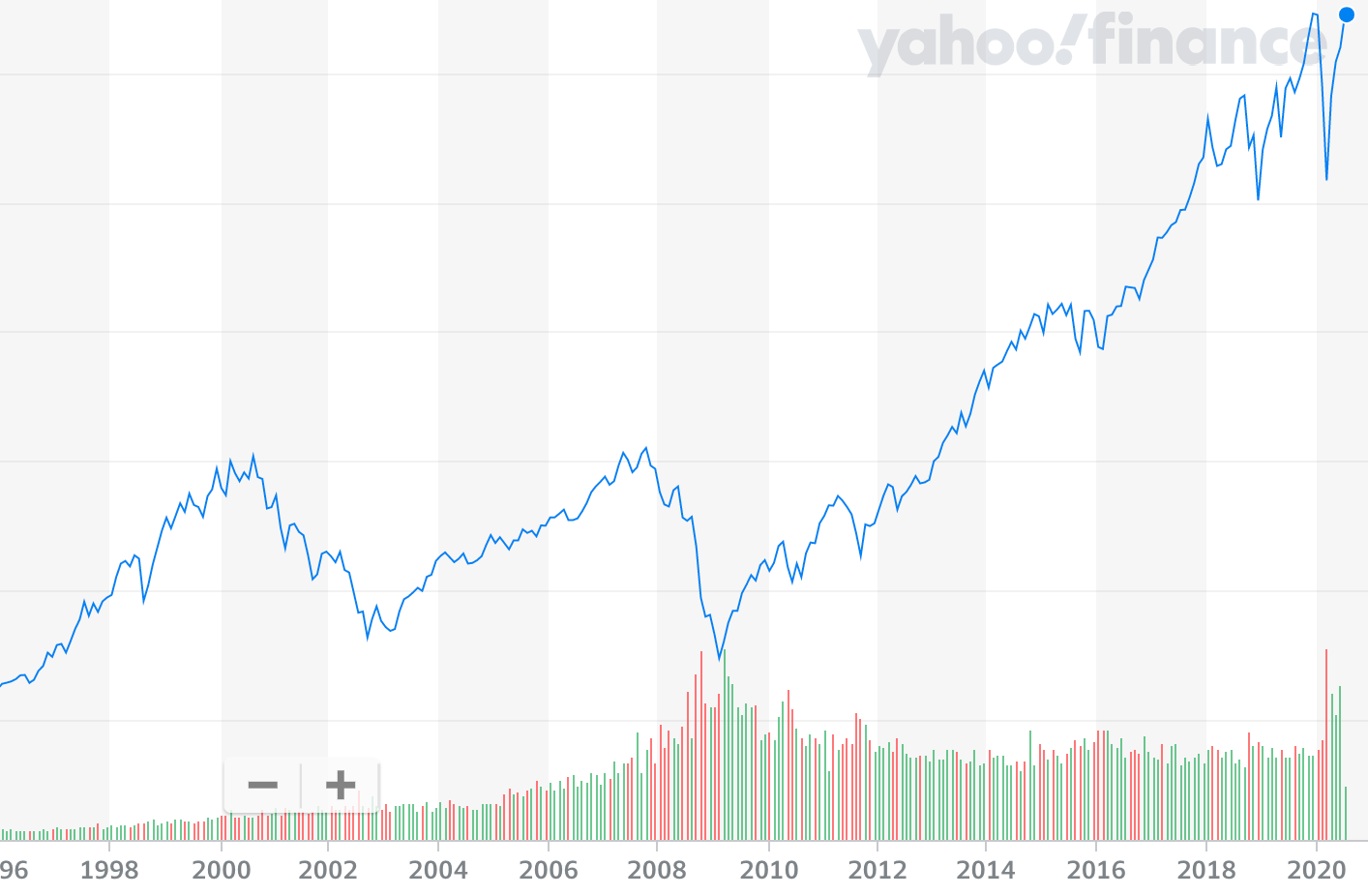Long Term Investment in Stocks
Investing in the stock market as a novice can be intimidating. Let’s look at some things you should consider or understand about this form of investment.

I mentioned in the opening post of this series that on average over any decade, the stock market grows by at least ten per cent. This rate of return beats about any other type of investment regularly and must be part of your investment portfolio.
There are some warnings to consider before you dive in, and also note that your financial situation may be completely different; always seek independent advice from a qualified financial adviser.
The Bear
The first thing to note is the cyclical nature of the market. While it has generally gone up over the years there have been major downturns along the way. Just over a decade ago beginning in 2007, the market was affected by the sub-prime mortgage collapse. Not even ten years before that the Dotcom boom wiped billions from the market. And most recently, Covid-19 has had a huge impact on prices.

Looking at a long term view of the S&P500 index you can see that there have been crests and troughs to market, with the pattern looking like a wave. If you go down the path of investing in the stock market, then there will be a time when companies that you are invested in are under performing. Perhaps not because of some fault of the company itself, but because the market itself is behaving like a depressed teenager where everything tastes and looks like crap.
The Bull
The other side of this is when things are rising. Even rubbish stocks will be buoyed by a general good feeling in the market. Some companies will be manically traded and talked about by everyone; their directors will be able to do no wrong and everyone will want a piece of the action they provide. Only time will tell whether they deliver continued growth at the rate everyone expects.
There have been numerous cases where public hysteria has driven prices so high that under normal circumstances the price would not be conscionable. But with the weight of opinion from market analysts it can seem that it would be foolish not to miss out on the hot stock.
Within recent memory is the dot-com bubble which began in the late 1990s with over speculation in technology shares. This led to dramatic losses of value early in the millennium with companies such as WorldCom and Pets.com failing entirely when the promise of earnings power were finally revealed to be based on shaky foundations.
For a historical reference the tulip mania from led to ridiculously high prices for tulip bulbs during the Dutch Golden Era. Isaac Newton himself is said to have invested having been swept up by the hysteria, ultimately losing money when the market collapsed. Even superior intellect does not stop you become enthralled in a craze.

Is the price of Amazon shares too high at the moment? A single share in the company is going for above $3,200 right now. The company does not pay regular dividends, so all earnings are retained to invest in further growth, which might explain why the price is climbing. But in order to make your ten percent return, you would have to be sure that this growth is going to continue over the next decade.
Is that a safe assumption? I’m not sure. It is certainly an exciting time for Amazon executives. But maybe the big rise in value has already taken place – from someone on the outside, it may be too late.
Cover the Basics
There are a number of basic rules that we can make before putting our savings into the stock market. The first is that since there is no way of knowing when the next downturn is going to happen, nor how long it is going to affect markets, we may need to leave our money invested for a long time. We cannot think of a stock market investment as being money that we can spend.
Before investing, save up enough for about three months of expenses (you do have a budget to predict your expenses, don’t you?). Place this money in a fixed term savings account with no longer than one month notice required. If you need cash for an emergency, you can take it from here and not incur the expense of stock trading, or the risk of opportunity loss by not being in the market when it swings in your favour to pay for basic needs.
This buffer should be kept forever and only be used when you cash flow is tight. Remember to periodically check how much you are spending so that the amount in the budget is enough to cover a quarter of the year’s expenses. You can try different savings or cash equivalent products to increase the return, but this fund’s purpose is primarily to avoid having to sell shares.
Long View
It can be a good idea to try to save or invest for a particular goal. Maybe you are trying to come up with the deposit for a real estate purchase, or perhaps you want to be financially strong enough to retire in your fifties. These are both good goals to have but the time line they sit on may be quite different. It all depends on your personal circumstances.
Perhaps you want to purchase the house within five years. In that case you may be better off sticking with a traditional savings account, so that there is little or no risk to a dropping of the value of your money; the inflationary effect may not be that bad on so short a time frame.
Saving for an early retirement, however, may be twenty years down the line. This may be a lot more suited to stock market investing. It is also a lot more vague about what the target is. In twenty years time, how much money will you need to survive to maintain the lifestyle that you want? Difficult to be precise this far out.

Whatever target that you have in mind now, might be insufficient by the time you get there due primarily to inflation, that mysterious effect that reduces the buying power of money. The good news is that the stock market has been good at advancing faster than inflation over any reasonably long period.
Taking a long view to your investment will protect you from reacting to the periodic market dips. Don’t panic. Keep in mind that you are investing for ten or more years in the future, and that things will probably recover during that time. You can continue to invest during the dip and increase potential returns. We’ll talk more about this form of investing, dollar cost averaging, and how it can help a small investor, in a later post.
Hard Timing
“Buy low, sell high” is a maxim you may have heard people say when talking about stock dealing. It is incredibly easy to understand. If you buy at the bottom of pessimistic market and sell a top of an optimistic one, then you can make a fortune. The reality is that timing things well enough to beat all the other people trying to do the same is about as difficult as it comes.
The tendency will be that you buy too early, when there is still room to drop further, or you sell too early, when things have further to rise. And that’s if you are good! Most of us will fall into selling at the absolute worst times. Ben Graham likened trying to time the market to attempting to swim against the tide. Make a mistake on timing and it will hurt.

A more practical way of investing is to buy and hold. The steps are as follows: carefully select a sound investment that is selling at or under its intrinsic value, purchase shares as a once off or regularly over a period of time, and re-evaluate the stock every quarter.
The intention is to find solid, reasonably large companies, with good reputations that are likely to be around for a long time. Unfortunately the cost of acquiring shares like this can be high; that is why the comment about intrinsic value is important. Understanding the intrinsic value of a company is vital to making sound purchases. Intrinsic value is different from the market value, which is the price stockholders place on a company by deciding at what price to purchase or sell shares.
Intrinsic value goes more deeply into how valuable a company is. What assets does it have? What customers? What is its earning potential? How important is its brand to keep competitors out of its chosen market? Can it withstand disrupting newcomers? Some of these questions are subjective; you may put a different value on a company to someone else. That’s OK, but try to figure out the intrinsic value by your own criteria, compare this to the market value, and don’t ever pay too much above that price for shares.
Avoid Gambles
We have all heard of individuals who boast about selecting a stock when it was selling at a low price and making a fortune when it sky-rockets. Take shares of Apple as an example. Back in the early years of the millennium it was trading for about $2 with perhaps not a great outlook and then the iPhone happened. Now it‘s shares are above $350. But is the person telling you how much they invested in other stocks that did not do so well? Perhaps this one winner is balanced against a dozen other losers.
While it does make sense to have a diverse portfolio (we’ll talk more on that in a later post), which may include some speculative investments, try to keep the amount you invest in these sort of stocks to below a threshold that you decide in advance.
For example, perhaps ten to fifteen percent of you investments can be growth stocks, ones that the market thinks have plenty of opportunity to grow into, but are selling below that price at the moment. The problem with these stocks is that if the market knows about them, then the price will already be above a good investment price; you will be buying at a price where all you can do is hope the company is a winner.

Picking winners can be as difficult as timing the market perfectly. Buying stocks that appear cheap may result in some that become giants but there is risk involved. The likelihood is that you will choose many more losers than winners. Avoid putting all your money into a small number of stocks that might grow. If you can spread your investment across a range of potential winners, you will have more success.
Try to find companies that are not in danger of collapse. The idea is to make an investment, not gamble your hard earned money. Do you own research and due diligence into the founders, executives and the financial statements.
Don’t Believe the Hype
Benjamin Graham introduced the idea of a notional person, Mr. Market, that represented the fluctuating prices we see in stock markets. He is the type of character that will burst into your office when he is in a positive mood and try to convince you that all sorts of overpriced stocks are worth holding and will be eager to buy whatever you have at any price. When he is feeling blue, he will not believe that any company can survive and will sell you stock at rock bottom prices.
Try to ignore these extreme moods and make your own mind up. The intrinsic value of a company does not change overnight, but its market value can if a mood of pessimism overtakes Wall Street. Be aware of what the general market is thinking, but never rush to get involved in its activity.

Better to take a step back and try to understand why things have changed. Are they likely to change back? Does it really change your strategy of a long term investment plan? You should not be overly concerned with any huge market swings when taking this sort of view.
Perhaps you will find stocks that fall under their intrinsic value during lulls in the market, or you may find that a stock you hold is priced far above what it should be. In the latter case, selling some or all of the stock may now make sense. In the former, you might now be able to invest with some degree of safety and chance for growth.
Advice
- Decide on a goal. Make sure that it is set far enough into the future, say ten to fifteen years. This is an appropriate amount of time to aim for when considering investing in the stock market.
- Start with virtual trading account that lets you use play money at real prices. See how your investments do before plunging into real stock purchasing.
- Start saving money in normal bank account to act as either initial investment or a buffer to protect against having to sell shares to generate cash in an emergency.
- Research if there are low cost brokers operating in your jurisdiction and make sure they are reputable.
